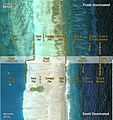Reef geomorphology
Global Views of Coral Reef Geomorphology
From Research Vessels
Darwin
From Orbiting Satellites
Remote Sensing
From Google Earth
Until very recently, a synoptic view of reef geomorphology showing the impact of varying ecological processes has not been possible, and previous attempts to summarize information have had to rely on parochial descriptions of what was accessible or visible at the time (e.g., Hopley, 1982; Guilcher, 1988). Following this approach, vast areas of modern reefs have been inadequately characterized and, with some exceptions, quantitative differences and the similarities between different regions have gone undocumented. This deficient situation is about to change. The recent advent of widely available orthorectified satellite imagery (Google Earth) and rapid development and cost reduction in geographic information systems, multi-beam sonar, LiDAR, and other remote-sensing technologies are making large-scale morphometric quantification of reefs feasible (Naseer and Hatcher, 2001; Andrefouet et al., 2001; Storlazzi et al., 2003; Naseer and Hatcher, 2004). As such, we are on the cusp of being able to provide a more holistic view of modern coral-reef form and a development that will provide timely insight into the resilience and resistance of reefs to human-induced global environmental change. In this entry, satellite imagery from Google Earth is used along with local descriptions of reefs and attempt to summarize what is presently known about the geomorphy of coral reefs, outline their formative processes, and assess their development.
Geomorphic Reef Zonation
The coral reefs of the Atlantic, the Caribbean and the Indo-Pacific do not differ fundamentally in their structural forms, their habitats and the interaction of their species, even though the organisms occupying specific ecological roles vary greatly between oceans and even between individual reefs (Goreau et al. 1979, p. 135). Despite the similarity between the geomorphology of coral reefs noted by the Goreaus and others (Wells, 1957; Stoddart, 1969), much of the emphasis in characterizing coral-reef zonation has been ecological using either statistically defined coral assemblages or more simply, the morphology of the corals themselves (Wells, 1957; Rosen, 1975; Geister, 1977; Pichon, 1978; Chappell, 1980; Done, 1982; Done, 1983). Most of these studies have found that shallow coral assemblages show a distinct zonation as wave energy, and hydrodynamic disturbance varies with depth and margin exposure. For example, Done (1982) found that shallow communities changed with a decreasing cross-shelf wave exposure in the central Great Barrier Reef. Individual reefs also showed the same pattern, with shallow-wave-adapted communities being replaced along leeward margins by upward shifts in the positions of deeper communities. Growth form of corals also show similar zonation patterns in response to depth and exposure-related variation in wave energy (Pichon, 1978; Chappell, 1980; Madin and Connely, 2006). Such zonation patterns have led to a clear distinction between rough-water reefs exposed to trade-wind-, swell-, and storm-generated wave fields and calm-water reefs protected from them (Geister, 1977, 1980).
A comparison of zonation schemes, however, shows that the coral assemblages in each zone can be highly variable on both inter-reefal and regional scale, and there is a significant overlap between the members of each assemblage zone (e.g., Done, 1982). Despite this “coral-scale” variability, the geomorphology of these reefs is very similar. Indeed, equally similar reef structures are produced in areas with order-of-magnitude differences in species abundances, and even where reefs have depauperate species numbers, their basic geomorphology is identical (e.g., Glynn et al., 1996). This consistency implies that gradients in wave exposure not only control the main environmental tolerances of shallow coral assemblages but also the form of the structures they build (Graus et al., 1977; Graus and Macintyre, 1989). It therefore follows that reefs might be better classified according to their geomorphic form (Wells, 1957).
Standard Zonation
A comparison of well-ordered, rough-water reefs shows a remarkable degree of conformity between the size and character of their major morphological features. All of them consist of five first-order or “standard” zones: a calm reef lagoon, with varying number of patch reefs; a largely barren, shallow reef flat strewn with detritus; a narrow, gently sloping reef front exposed to waves and swells; a steeper reef slope bearing corals to as deep as 100 m; and a less steeply inclined fore-reef apron, where coral and reef detritus accumulate (Figure 1). The boundaries between these standard zones are delineated by simple slope breaks. The break between the lagoon and the reef flat is either a sand slope or a small reef scarp. The break between the level reef flat and the gently sloping reef front occurs at the reef crest. Similarly, the shelf break separates the gently sloping reef front from the steeper reef slope, and the break between the reef slope and fore reef is the transition into slopes that reflects the angle of sediment repose. Each of these standard and easily defined reef zones can in turn be subdivided into commonly recurring second order zones or subzones, which may not be present on all reefs and, if they are present, may vary between margin, area, and region. As a consequence, their boundaries can be more difficult to define.
Reef Lagoons
Patches, Knolls and Pinnacles, Cellular Networks
Reef Flats
Algal Rims, Coralgal Flat, Sediment Flat, Island and Storm deposits
Reef Fronts
Spur and Groove, Mid-shelf Scarp, Sand Terrace
Reef Slopes
Chute and Buttress, Upper Reef Slope, Lower Reef Slope
Fore Reefs
Talus aprons
Physical and biological controls on Reef Geomorphology
Reef Zonation
PAR limitation on coral growth forms with depth
Biomechanical limitation on coral and algal growth forms and therefore zonation
Wave exposure (Trades, extratropical swell) around reefs and with depth
Wave-set up (wave pumping) and its impact on reef flats and lagoons
Tides and their modulation of waves and currents on reef flats and lagoons
Storms and their effects on reef-front and reef-flat zonation
Tsunamis.
Reef Types
Wind-wave, swell, storm directions predict reef types
Geological controls on Reef Geomorphology
Reef Zonation
relative sea-level changes (coseismic, eustatic)
Reef Types
Darwin Point relative sea-level changes
